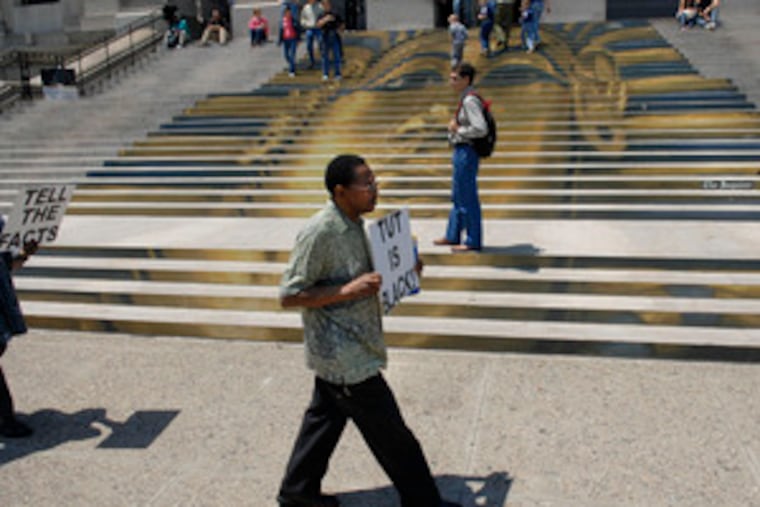Protesters at exhibit say King Tut was black
Molefi Asante, professor of African-American studies at Temple University, led a protest yesterday in front of the Franklin Institute claiming the museum's exhibit on King Tutankhamun is racist.

Molefi Asante, professor of African-American studies at Temple University, led a protest yesterday in front of the Franklin Institute claiming the museum's exhibit on King Tutankhamun is racist.
"This is a crime scene," he shouted. "This is an area of criminal theft, identity theft."
Among the grievances shared by members of the Association of Kemetic Nubian Heritage, of which Asante is president, is that the exhibit has no mention of Africa and that information within suggests that King Tut, an African, was white.
Asante specifically pointed to a representation of Tut that "looks more like Boy George than the boy king."
About 50 protesters walked in front of the crowded museum stairs carrying signs bearing statements including "Nefertiti is my sister," "Stop stealing our history" and "King Tut's daddy was black."
Asante said the exhibit doesn't tell visitors Egypt is in Africa, and he believes that many people leave thinking Egypt is in Europe.
He claims the museum did this for "commercial reasons."
Bolden Jerry, 62, a protester from Overbrook Park, agreed.
"They're trying to make it more accessible, more appealable to white people. It's all about making cash," he said.
Yesterday's protesters in Philadelphia were not alone. From Los Angeles to Fort Lauderdale, demonstrations have been held against the exhibit in every city it's visited since coming to this country in June 2005.
A spokeswoman for the Franklin Institute, who declined to give her name, said images of Tut vary throughout the museum.
"In the exhibit, you see Tut portrayed in all skin colors," she said. "In many of the paintings he is definitely black."
In response to the protest, the museum will hold a symposium at a yet-to-be-determined date in July. Scholars and experts will be invited to discuss forensic evidence relating to King Tut.
"We present ideas to the community and let them form their own judgments," the spokeswoman said. "We're happy to allow the Franklin Institute to be a forum for this discussion."
When King Tut's head was re-created by three forensic teams in 2005 using CAT scans of his skull, race was among the hardest physical features to determine, according to a National Geographic article.
Tut's race is "likely to remain forever unknown," the article said.
Asante said that ancient Egyptians were "black-skinned" and that Kemet, the name given to Egypt by ancient Egyptians, means "the black country."
Jordan Lynch, 17, a white high school student from Fredericksburg, Va., said he had found more interesting aspects of Tut than the color of his skin.
"I didn't go in there saying, 'Is King Tut white or black?' I went in there wanting to learn about history," he said. "I'm more interested in how he died than whether he was white or black."
George Williams, who is black and operates a pretzel cart in front of the museum, said he believes that King Tut is a piece of history all people share.
"Regardless if he was black or white, we're all equal and we're all [descendants] of King Tut," he said. "We can love each other."